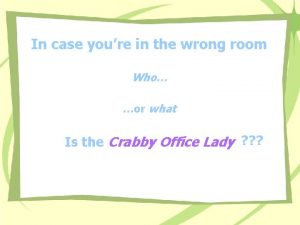What do you think No youre wrong Classroom






- Slides: 6

What do you think? No, you’re wrong! Classroom Conversation Discussion Well, what about me? Types Preparing Successful Discussions Common-sense Rules Benefits & Problems Creating a Discussion Rubric YES! How would you feel? He’s wrong.

Types of Discussions General (gives students a chance to develop thinking, clear oral expression, and experience in posing and responding to questions) Guided or Directed (used to guide students through a series of questions to discover some relationship, principle, or result) Reflective (used to assist students in analytical skills, arriving at alternative explanations, finding solutions, or classifying ideas into major categories) Inquiry (used to help students employ reasoning skills to acquire new information with a minimum of help from the teacher) Exploratory (used to enable students to discuss controversial issues without fear of censure)

Preparing for Successful Discussions set realistic goals determine type of discussion pay attention to thought processes required to achieve goals outline questions in light of required thought processes – – provide for variety of questions should be at student level prepare a novel introduction follow common-sense rules

Common-Sense Rules use wait time effectively move from divergent to convergent questions reinforce student answers throw back questions provide appropriate praise interrelate previous comments maintain positive atmosphere clarify statements with follow-up questions restate goal periodically engage all students take your time

Benefits & Drawbacks Benefits – motivates individual students – more likely to develop inquiry behavior in students – teacher receives feedback from students – an opportunity to engage all students in thinking – scope of discussion can be rather broad - integration – a good way to provide for review Drawbacks – hard to conduct well – may go astray – can be time consuming – may be monopolized

Rubric for Evaluating Discussions Defines important aspects of a good discussion – – – effective initiation of discussion educational objective stated / achieved? equitable student participation quality of student responses students answer the questions question types / skills Uses an even-numbered scoring scale. Characterize quality performance from good to poor.











